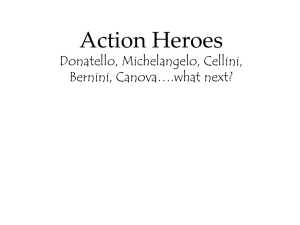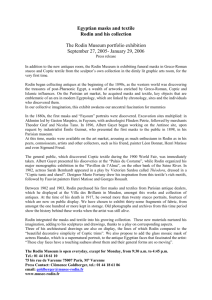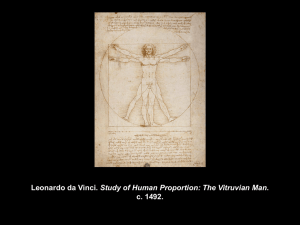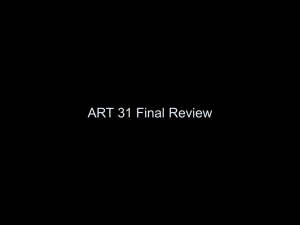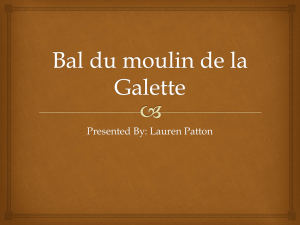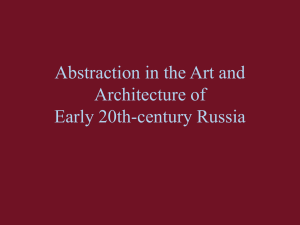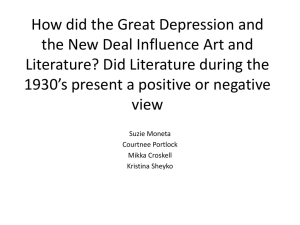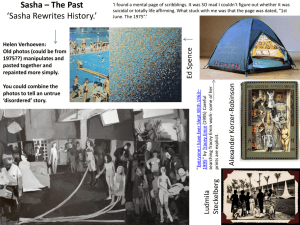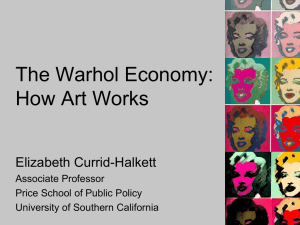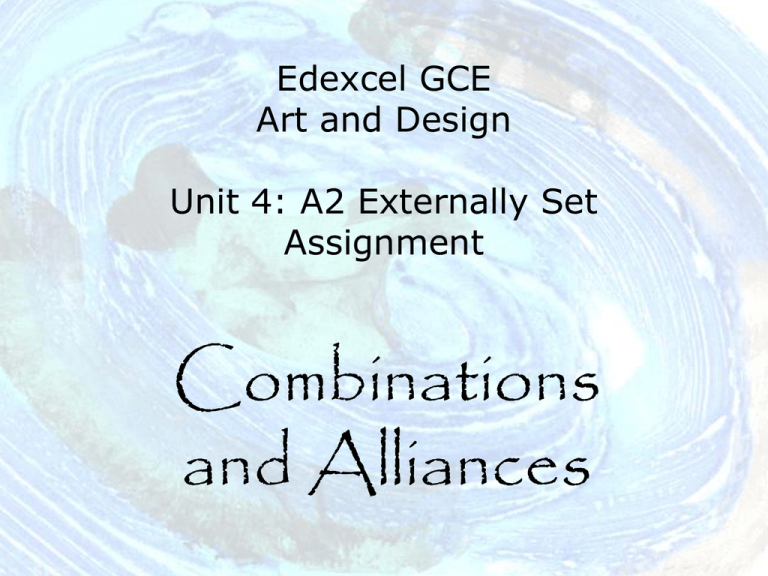
Edexcel GCE
Art and Design
Unit 4: A2 Externally Set
Assignment
Combinations
and Alliances
Michelangelo and Pope Clement VII
In 1534
Michelangelo's
childhood friend,
Pope Clement VII,
was dying.
Desperate to make
one last grand
gesture, he
summoned
Michelangelo to
complete his work
in the Sistine
Chapel. This was
the perfect
opportunity to
express years of
fear and
resentment. Across
the altar of the
Sistine Chapel, he
composed a
vicious tableau of
terror and pain:
“The Last
Judgement”.
http://www.wga.hu/tours/sistina/index_d.html
Caravaggio and Cardinal Francesco Maria del Monte
Caravaggio, by name of Michelangelo Merisi, Italian painter whose revolutionary technique of tenebrism, or
dramatic, selective illumination of form out of deep shadow, became a hallmark of Baroque painting.
Scorning the traditional idealized interpretation of religious subjects, he took his models from the streets and
painted them realistically. His three paintings of St Matthew (c. 1597-1602) caused a sensation and were
followed by such masterpieces as The Supper at Emmaus (1601-02) and Death of the Virgin (1605-06).
… In 1595, his luck changed. An eminent Cardinal, Francesco del Monte, recognized
the young painter's talent and took Caravaggio into his household. Through the
cardinal's circle of acquaintance, Caravaggio received his first public commissions which
were so compelling and so innovative that he became a celebrity almost overnight…
Vincent van Gogh and Paul Gauguin
Vincent van Gogh and Paul Gauguin's meeting in Paris
marked the beginning of one of the most talked about
artistic friendships in the history of art. It was a
relationship in which hope and disappointment,
camaraderie and rivalry, admiration and jealousy
constantly alternated, and which captivate both artists
emotionally and artistically until their death.
http://www.artic.edu/aic/exhibitions/vangogh/slide_intro.html
http://www.vangoghgauguin.com/
http://www.vangoghgallery.com/influences/
Auguste Rodin and Rose Beuret
Rose Beuret went as a country girl to Paris to start work as a seamstress in one of the many workshops. It
was there where she met Rodin and, in his own words, "clasped to him like an animal". Two years later she
gave birth to a son, who was never acknowledged by the father. She remained his partner for over 50 years
and only married him in 1917, a few days before she died. Rose was a lifelong stable factor in the
background for Rodin. She was not part of his social life though and had to put up with a lot. She regularly
modeled for Rodin which becomes even more fascinating when you keep in mind the later role she played in
Rodin's life.
In 1883, Rodin met the 18-year-old
Camille Claudel. The two formed a
passionate but stormy relationship
and influenced each other
artistically. Claudel inspired Rodin
as a model for many of his figures,
and she was a talented sculptor,
assisting him on commissions.
In 1889, the Paris Salon invited Rodin to be a judge on its artistic jury. Though Rodin's career was on the rise,
Claudel and Beuret were becoming increasingly impatient with Rodin's "double life". Claudel and Rodin shared
an atelier at a small old castle, but Rodin refused to relinquish his ties to Beuret, his loyal companion during the
lean years, and mother of his son. During one absence, Rodin wrote to Beuret, "I think of how much you must
have loved me to put up with my caprices…I remain, in all tenderness, your Rodin.” Claudel and Rodin parted in
1898.
Gilbert and George
George was born in Devon in 1942. Gilbert was born in
Italy in 1943, in a small village in the Dolomites. They met
as students on the sculpture course at St Martins School of
Art, London, where they exhibited together and soon
began to create art together. They adopted the identity of
‘living sculptures’ in both their art and their daily lives,
becoming not only creators, but also the art itself.
Gilbert & George place themselves,
their thoughts and their feelings at
the centre of their art, and almost all
of the images they use are gathered
within walking distance of their home
in London’s East End. Yet their
pictures capture a broad human
experience, encompassing an
astonishing range of emotions and
themes, from rural idylls to gritty
images of a decaying London; from
fantastical brightly-coloured
panoramas to raw examinations of
humanity stripped bare; from sex
advertisements to religious
fundamentalism.
http://www.tate.org.uk/servlet/ArtistWorks?cgroupid=999999961&artistid=1163&page=1
Anthony Green and Mary Cozens-Walker
Green and Cozens-Walker are a British husband
and wife artist team. They are both painters, at the
simplest description, but then their work goes far
beyond any categorization. Green makes three
dimensional paintings. Cozens-Walker does
multimedia creations that employ stitching, textiles,
painting and lots more.
http://www.anthonygreen.org.uk/
http://marycozenswalker.co.uk/index.html
Diego Rivera and Frida Kahlo
The marriage of Diego Rivera and Frida Kahlo is one of the most
famous alliances between artists. It is a well-known fact that they
had a passionate and stormy relationship, filled with great love
and also betrayals. They both had incredible talents and vision,
but Diego's work would be more public and monumental, whereas
Frida's was more personal and intimate in scale.
During her own lifetime Frida owed
much of her renown as a painter to
the fact that she was married to Diego
Rivera. After years in his shadow, she
is now even more famous than her
husband. By the early 1980s his
social realist murals began to look
outdated, and Kahlo was being
rediscovered. Her portrayal of her
own physical and emotional pain
spoke to a new generation of
feminists and to those more
concerned with personal feeling than
grand ideologies.
Charles Saatchi and the Young British Artists
YBA is the name given to a loose group of visual artists who first began to exhibit together in London, in
1988. The scene began around a series of artist-led exhibitions held in warehouses and factories. They are
noted for "shock tactics", use of throwaway materials, wild-living, and an attitude "both oppositional and
entrepreneurial." They achieved considerable media coverage and dominated British art during the 1990s.
Many of the artists were initially supported and collected by Charles Saatchi. Leading artists of the group
include Damien Hirst and Tracey Emin.
My Bed was bought by Saatchi for £150,000 and
displayed as part of the first exhibition when the Saatchi
Gallery opened its new premises at County Hall, London
(which it has now vacated). Saatchi also installed the
bed in a dedicated room in his own home.
This work was funded by Saatchi, who in 1991 had offered to pay
for whatever artwork Hirst wanted to create. The shark itself
cost Hirst £6,000 and the total cost of the work was £50,000.
The shark was caught by a fisherman commissioned to do so, in
Australia. Hirst wanted something "big enough to eat you".
Dutch Still-lifes in the 17th Century
Vanitas is the Latin for vanity, in the sense of emptiness or
a worthless action. 'Vanity of Vanities, saith the preacher,
all is vanity' means all human action is transient in contrast
to the everlasting nature of faith.
A vanitas is a particular type of still life painting in which
objects symbolically refer to such a theme. For example, in
Steenwyck's 'Allegory' in the Collection, objects which
suggest human achievements, like the book and
instruments, are related to reminders of mortality: the lamp
which has been snuffed out and the skull.
Patrick Blanc
Patrick Blanc is a botanist, working at the French National Centre for Scientific Research, where he specializes
in plants from tropical forests. He has invented the green wall.
http://www.verticalgardenpatrickblanc.com/
Edouard Francois
Edouard François has become one of the
protagonists of green architecture on an
international scene. His work focuses on matter,
context, use, economy and ecology, following
the preoccupations of sustainable development.
Francois’ European team of architects and
urbanists are working also on landscape design
and graphic design projects.
http://edouardfrancois.com/
Henri Cartier-Bresson
“To take a
photograph
is to align
the head,
the eye
and the
heart.
It's a way
of life."
Henri Cartier-Bresson was a French photographer considered to be the father of modern photojournalism. He
helped develop the "street photography" or "real life reportage" style that has influenced generations of
photographers who followed.
Urban plants and wildlife
Characterized by an abundance of pavement, reflected heat, polluted air and contaminated soil, our cities
and towns may seem harsh and unwelcoming to vegetation. However, there are a number of plants that
manage to grow spontaneously in sidewalk cracks and roadside meridians, flourish along chain-link fences
and railroad tracks, line the banks of streams and rivers, and emerge in the midst of landscape plantings and
trampled lawns. On their own and free of charge, these plants provide ecological services including
temperature reduction, oxygen production, carbon storage, food and habitat for wildlife, pollution mitigation,
and erosion control on slopes. Around the world, wild plants help to make urban environments more
habitable
for people.
Urban wildlife is wildlife that can
live or thrive in urban
environments. Some urban
wildlife, such as house mice, are
synanthropic, ecologically
associated with humans. Different
types of urban area support
different kinds of wildlife. One
general feature of birds species
that adapt well to urban
environments is they tend to be
the species with bigger brains,
perhaps allowing them to be more
adaptable to the changeable
urban environment.
Peter Howson
http://www.peterhowson.net/
http://www.flowersgalleries.com/artists/118-artists/3792-peter-howson/
Maggi Hambling
http://www.maggihambling.com/
Howard Brodie
“I remember the young soldier well, he screamed, he was just out of control, and he screamed, and
there was another soldier next to him who consoled him, and embraced him. That was a moving moment
for me, to see that compassion in combat. And these are the things a person feels when he's in
proximity to death-- his buddy, that next human being, that person in the foxhole is the most
important person in your life.”
http://www.pbs.org/theydrewfire/artists/brodie.html
“My most searing memory of any war was during the battle of the bulge, when Germans posing as GI's
infiltrated our lines. I heard we were going to execute three of them…A defenseless human is
entireley different than a man in action. To see these three young men calculatingly reduced to
quivering corpses before my eyes really burned into my being. That's the only drawing I've ever had
that's been censored. All coverage of the execution was censored.”
Vasily Vereshchagin
John Singer Sargent
Graham Sutherland
http://www.tate.org.uk/servlet/ArtistWorks?cgroupid=999999961&artistid=2014&page=1
Theodore Gericault
Le Radeau de la Méduse (The Raft of the Medusa), 1818–1819, Oil on canvas
At 491 cm × 716 cm it is an over-life-size painting that depicts a moment from the
aftermath of the wreck of the French naval frigate Medusa, which ran aground off
the coast of today's Mauritania on July 5, 1816. At least 147 people were set adrift
on a hurriedly constructed raft; all but 15 died in the 13 days before their rescue,
and those who survived endured starvation, dehydration, cannibalism and madness.
In choosing the tragedy as subject matter for his first major work—an
uncommissioned depiction of an event from recent history—Géricault consciously
selected a well-known incident that would generate great public interest and help
launch his career.
The event fascinated the young artist, and before he began work on the final
painting, he undertook extensive research and produced many preparatory
sketches. He interviewed two of the survivors, and constructed a detailed scale
model of the raft. His efforts took him to morgues and hospitals where he could
view, first-hand, the colour and texture of the flesh of the dying and dead. As the
artist had anticipated, the painting proved highly controversial at its first appearance
in the 1819 Paris Salon, attracting passionate praise and condemnation in equal
measure. However, it established his international reputation, and today is widely
seen as seminal in the early history of the Romantic movement in French painting.
Caspar David Friedrich
Sea of Ice, 1823-1824, Oil on canvas
‘This scene has been descried as ‘a stunning composition of near and distant
forms in an Arctic image’.
With dawn and dusk constituting prominent themes of his landscapes, Friedrich's
own later years were characterized by a growing pessimism. His work becomes
darker, revealing a fearsome monumentality. The Wreck of the Hope - also known as
The Polar Sea or The Sea of Ice - perhaps best summarizes Friedrich's ideas and
aims at this point, though in such a radical way that the painting was not well
received. Completed in 1824, it depicted a grim subject, a shipwreck in the Arctic
Ocean; "the image he produced, with its grinding slabs of travertine-colored floe ice
chewing up a wooden ship, goes beyond documentary into allegory: the frail bark of
human aspiration crushed by the world's immense and glacial indifference."
Tom McGrath
Wreck 2, 2005, oil and alkyd on canvas
Diego Velázquez
The Family of Felipe IV, or Las Meninas, ca. 1656, Oil on canvas, 318 cm x 276 cm
A portrait of the infant Margarita, daughter of Felipe IV (1605-1665), surrounded
by her servants or “family” in a hall of Madrid’s Alcázar Palace.
This, the most famous of Velasquez’s works, offers a complex composition built
with admirable skill in the use of perspective, the depiction of light, and the
representation of atmosphere.
There have been innumerable interpretations of this subject and later references
to it. The most numerous emphasize a defense of the nobility of painting versus
craft. Velasquez portrays himself, painting the painting itself, on the left of the
canvas, thus affirming the supremacy of the art of painting. The infant Margarita
(1651-1673), wears white and appears in the center of the composition,
surrounded by her ladies in waiting, the “meninas” María Agustina de Sarmiento
and Isabel de Velasco, along with two court buffoons, María Bárbola and
Nicolasito Pertusato, and a mastiff. Behind her, the duenna Marcela de Ulloa
converses with the quartermaster, José Nieto, who is in the doorway.
The King and Queen, Felipe IV and Maria de Austria (1634-1696) are reflected in
the mirror at the back of the room, leading to series of extraordinarily complex
spatial relations.
Ken Howard
http://www.kenhoward.co.uk/
The Crucible Exhibition
Gloucester Cathedral
‘Crucible’ at Gloucester Cathedral ran for nine and a half weeks from 1 September to 7 November 2010.
The exhibition displayed 76 works of art by 48 sculptors, many of whom are internationally famous artists.
http://www.crucible2010.co.uk/
http://www.gloucestercathedral.org.uk/index.php?page=crucible
Antony Gromley, Close V
Damien Hirst,
St. Bartholomew Exquisite Pain
Kenneth Armitage,
Reach for the Stars
Ralph Brown, Clochard
David Nash, Encased Cross
Bridget Riley
“No painter, dead or alive, has ever made us more aware of our eyes than Bridget Riley.”
http://www.op-art.co.uk/
http://www.theartstory.org/movement-op-art.htm
“The music of colour, that’s what I want”
Victor Vasarely
“The pebbles, the sea shells on the beach, the whirlpools, the hovering mist, the sunshine, the sky… in the
rocks, in the pieces of broken bottles, polished by the rhythmic coming and going of the waves, I am certain to
recognize the internal geometry of nature.”
Frank Stella
"What you see is what you see."
John Hoyland
Shortly after painting 'Saracen',
Hoyland stated: 'Paintings are not
to be understood, they are to be
recognised. They are an equivalent
to nature, not an illustration of it'.
Since executing his first abstract
works in 1958, Hoyland's paintings
have proclaimed their selfsufficiency as visual facts or events.
In the 1960s Hoyland was mainly
involved with formal issues of scale,
colour, and the relation of shapes.
In the 1970s he began to invest
these elements with a greater
emotive significance. Consequently,
as 'Saracen' demonstrates, his
handling of the forms in his
paintings became looser and more
gestural. He explained: 'The
structure of form is meant to be a
container for colour, a container of
feeling'.
Joan Miró
Howard Hodgkin
“My subject matter is simple and straightforward. It ranges from views through windows, landscapes, even
occasionally a still-life, to memories of holidays, encounters with interiors and art collections, other people,
other bodies, love affairs, sexual encounters and emotional situations of all kinds, even including eating...”
http://www.howard-hodgkin.com/
Binding together all his work is his consistent exploration of the representation of
personal encounters, emotional experience and memories of specific events.
Whether trips to India, Egypt or Morocco, social occasions such as dinner with
friends, particular moments are simultaneously reconstructed and obscured through
a layering of the picture surface with distinct marks and intense colours, often
achieved only over a period of several years.
“I go for a walk. Maybe I go to the British Museum and look at something. I try to forget about as much as
possible until I start thinking about what scale the picture will be…and then I think, ‘Is this going to be a
little picture or a big picture?...I think more and more about the painting, then I make a mark and anther, and
then the trouble starts.”
“I start out with the subject and naturally I have to remember first of all what it looked like, but it would
also perhaps contain a great deal of feeling and sentiment. All of that has got to be somehow transmuted,
transformed or made into a physical object, and when that happens, when that’s finally been done, when the
last physical marks have been put on and the subject comes back – which, after all, is usually the moment
when the painting is at long last a coherent physical object – well, then the picture’s finished and there is no
question of doing anything more to it. My pictures really finish themselves.”

